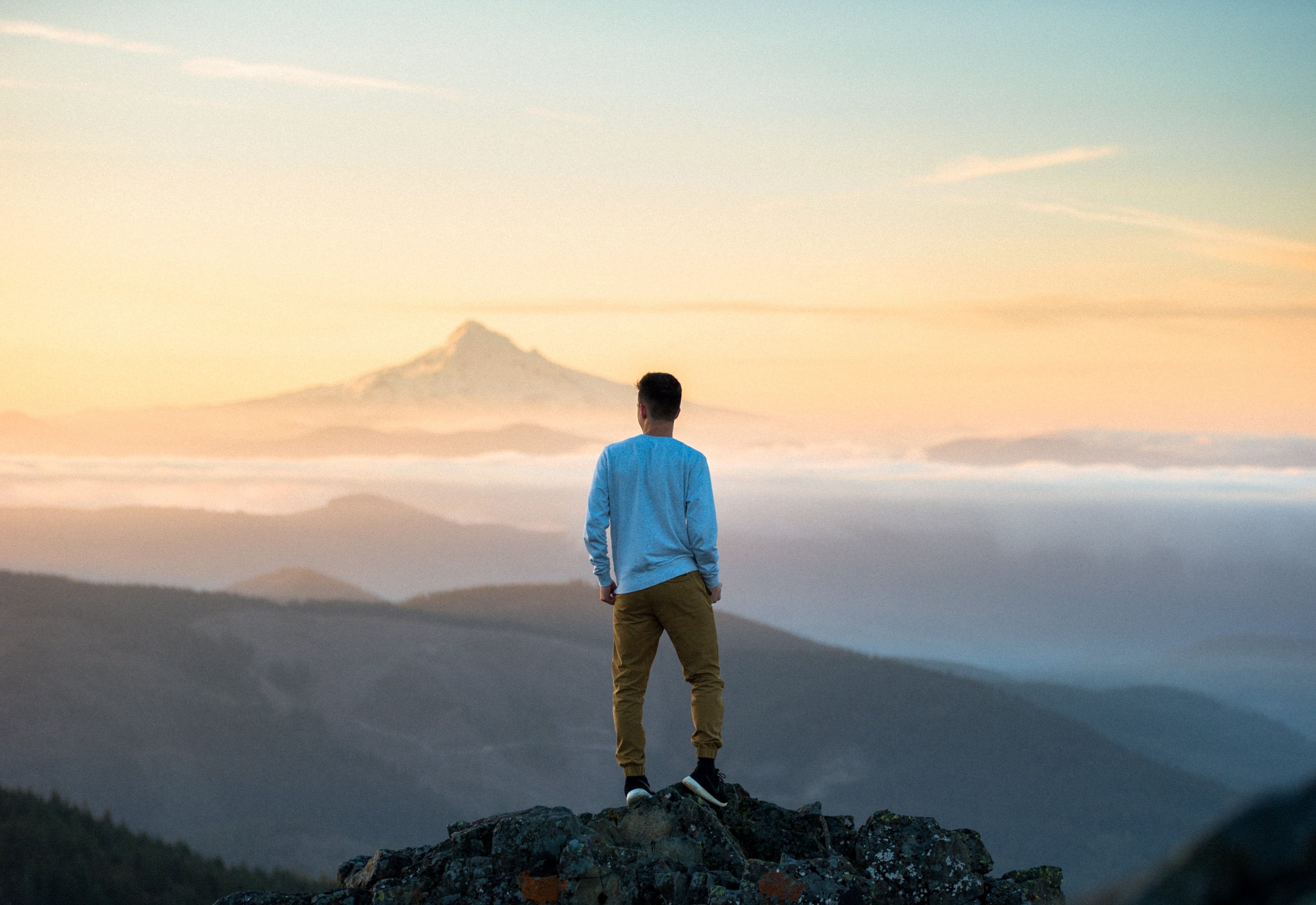It’s None of My Business

Have you heard of that thought-provoking question people often ask in a “get-to-know” group setting? “What would you do with your life if money wasn’t an issue?” It’s a fair question. It will definitely help you look deep within and even examine your current life status and purpose. This can often lead to asking yourself another question… “Why am I doing what I am doing?”
But, I have a better thought-provoking question for you. But first, a story.
I immigrated to the US when I was 10 years old with my mom, my dad, and my older sister. We were a happy family of 4. My dad is a dreamer and wanted something better for himself and for us. I remember vividly the excitement of this new life. I am also a dreamer, and I’ve always dreamt of experiencing America to the fullest—the richness, the endless opportunities, the gigantic malls, the beautifully developed communities… oh, and Disneyland. I couldn’t wait to go there.
Turns out, the transition to the whole new, unknown world isn’t as easy as it seems. And the dreams that were so visible weren’t as reachable as shown in the movies. In fact, looking back, that very transition became one of the toughest and most painful journeys I’ve experienced in my life. Not only as a kid experiencing rejection and being bullied for the first time at school, but lots were happening at home. There’s an unbearable amount of pressure and burden from my parents. Whether spoken or unspoken… or even sometimes screamed in my face, I soon realized that I carried the hope and the fulfillment of their “dreams” which rested on my tiny little shoulders. Was that even fair?
Looking back, these traumatic years re-shaped my core as a person. I learned to live my life on other people’s terms. They determined my identity. They determined my purpose. They determined my happiness. They determined how I should live my life. I didn’t want that to happen… it just did. What “they” thought of me mattered. It mattered so much.
I heard this quote about 10 years ago that made me think, and it goes like this…
“At 20, you care what everyone is thinking about you. At 40, you don’t give a damn what people are thinking about you. At 60, you realize no one is thinking about you.”
It’s kinda funny, isn’t it? I think there’s some truth to it. In fact, I think I am in the 2nd stage of life where I am learning to care less about what others think about me, and let me tell you, it’s been very freeing. Along the same thought, I heard this quote which I think is so profound and even more freeing in a way.
“What others think about you is none of your business.”
Whoa!!
Don’t get me wrong. This is not a license to be a complete jerk because you don’t care what others think about you anymore, but it’s a way to look deep within and be true to yourself and to rediscover yourself and to be confident in who you are.
So, here’s my second thought-provoking question that you’ve been waiting for. “What would you do with your life if you didn’t care what others thought about you?” If that’s hard to answer, let’s phrase it like this. “What would you do with your life if no matter what you did, others will think the best of you.”
We have work to do. We have our dreams to dream, goals to reach, people to love, purpose to fulfill, lives to live. We don’t have time to waste any of our precious energy being bullied by the naysayers or those critics of you. Because, you know what? What they think of me is none of my business. Carry on.
Don’t Give Up, Find the Way!

As I approach an age where I inquire about a separate senior citizen menu at restaurants, I’m searching for heroes in my own age group. What’s the point of having audacious goals if they’re simply physically impossible? For instance, most PGA professionals on tour and the young whipper-snapper high school/college golfers are hitting the ball past 300 yards with swing speeds of 120+ mph. Meanwhile, mine is in the 90s, and I can only manage to drive 230 yards at most. My dream of hitting the ball past 300 yards is long gone. Poof! Gone. It’s never going to happen. It’s physically impossible.
Or is it?
If you’ve been following my series on “Inspiration,” do I have a story for you! In fact, I’ve shared this story many times, and I revisit this video every year. Also, the documentary just came out, and I’ve finished watching it. Something about it pumps me up and makes me say out loud, “I am going to find a way!”
Diana Nyad is an American long-distance swimmer. She gained international fame for her extraordinary achievements in open-water swimming. One of her most notable accomplishments came in 2013 when, at the age of 64 (yes, you heard that right), she became the first human to swim from Cuba to Florida without the aid of a shark cage. To this day, no one else has accomplished this feat.
Her journey to achieve this extraordinary feat was marked by determination and perseverance—no kidding. She attempted the swim multiple times throughout her career, facing challenges such as dangerous sea conditions, jellyfish stings, and extreme exhaustion.
Despite setbacks, she remained committed to her goal and finally succeeded by swimming approximately a 110-mile stretch in about 53 hours. Yes, you heard that right—53 straight hours of swimming in the open sea. Pure determination, pure will, and pure courage!
Her achievement at an age when many consider retiring and ordering from a discounted menu has made her an inspirational figure, showcasing the power of resilience and the human spirit. Diana Nyad’s life story is not only one of athletic triumph but also a testament to the idea that age should not be a barrier to pursuing one’s dreams.
She’s also an incredible communicator and speaker. She has now written a book and continues to inspire many through her words of wisdom. Here are some of my favorite quotes that she lives her life by:
“When you achieve your dreams, it’s not so much about what you get; it’s about who you’ve become in achieving them.” Diana emphasizes the value of the journey, independent of the ultimate outcome. The pursuit of a dream is meaningful in its own right, regardless of whether the final destination is reached. For her, it was extra sweet for reaching the ultimate outcome.
This quote particularly speaks to me: “You can chase your dreams at any age – you are never too old!” Amen to that.
And how about this last quote: “Never, ever give up. Find a way.” This resonates beyond the realm of sports and swimming. It’s a reminder that in the pursuit of anything, there will be hurdles. But the key is to remain resilient, resourceful, and persistent. We have to focus, be creative, and be determined until we find a way.
Let’s find a way.
Here’s a TED Talk she did after her incredible feat that I watch every year. I hope you take the time to watch, listen and be inspired.
What I Learned From a Quote From an Avalanche Survivor

I grew up in Reno. When you want to travel to Lake Tahoe to witness the breathtaking views of the lake surrounded by snowcapped mountains during the summer or just simply want to take on the black diamond ski slopes during the winter, you fly into Reno. Tahoe is just hop-skip away to the wonders of Lake Tahoe and Reno is the closest city to have an international airport. In fact, as a kid growing up, we consider the ski slopes of Tahoe our own backyard. There’s a Junior Ski program that takes a bus full of kids every Saturday 30 minutes to the closest ski resort to get them started mastering the slopes early in their childhood. Our high school had a downhill ski team that competed against other schools in the county and some went on to become a professional skiers. All that to say, ski culture in Reno is second to none.
So, when I saw the trailer for this Feature Length Documentary called BURIED, based on the 1982 avalanche in Alpine Meadows (ski resort at Tahoe know for incredible summit-to-base groomed grails and panoramic views of Lake Tahoe and the peaks of the Sierra Nevada), I was intrigued and just had to watch it. Here it is…
In 1982, a massive avalanche had crashed into the base area of the ski resort after a four-day storm which had dumped close to eight feet of snow along with 100 mile per hour winds. The resort was closed but a few employees remained at the headquarters. And at 3:45 pm a tidal wave of snow came down and destroyed the building and buried the parking lot killing seven innocent lives. Here’s a crazy part of this story (warning: spoiler alert), one woman named Anna Conrad was found alive after being buried in the snow for a total of five days. She was located by a trained search dog, a German Shepard named Bridget. It took total of 117 hours for her to be found. It was a miracle beyond miracle that she was alive. She had been trapped in the second floor of a three-story ski lift building. She crawled into a space between all debris and a bench, surviving on melted snow.
When asked later while she was waiting to be rescued for 5 days if she ever gave up hope. “No.” She said. “I knew they would come” She never lost hope.
After this traumatic experience, the recovery back to the norm obviously wasn’t easy for her. She was dealing with the loss of her friends and the loss of the love of her life. At the same time, she was also trying to overcome survivor’s guilt of asking why. On top of that, the tough news she was told was that she would have to have her right leg amputated.
As devastating as that new way, this is how she responded. “What happened to me was a fantastic miracle, I can’t believe that I made it. It’s like so many miracles occurred all at once to save me, it’s just…it’s overwhelming. Learning about my leg amputation was very hard at first, but I decided there was no use being depressed, I was going to have to live with it so I might as well accept it.”
In the spirit of our new series “Inspiration”, I wanted to share this incredible survival story of Anna with you. I walked away from this documentary being reminded once again the fragility of life. And beyond that, I was inspired by her never giving up hope through one of the most hopeless circumstances. But most of all, I am inspired by her attitude of gratefulness and putting it all into perspective in the midst of her own painful journey. Her courage to accept, her courage to hope and her courage to live is inspiring. Are you inspired? My question now is how will this change and impact me? How will I learn to accept the things that doesn’t show up in my favor and how will I continue to see the hope and be grateful no matter what the circumstance I am facing? I would love to hear your thoughts.
Quotes that Changed Everything

Your FAQ Answered On Influencer Marketing

Good Vibes Only for Influencer Marketing

On a regular workday, Nathan found himself in an unexpected situation while heading to his job, his trusty truck suddenly called it quits right there on the highway. Instead of letting this disastrous circumstance ruin his day, Nathan decided to roll with the punches. With his skateboard in one hand and a bottle of ocean spray cranberry juice in the other, he simply shrugged off the inconvenience and carried on toward his workplace.
As he glided through the streets on this exceptionally lovely morning, Nathan had a spontaneous idea. He pulled out his smartphone and decided to capture a brief video of himself cruising along, all to share on the social media platform. He chose the iconic tune “Dreams” by Fleetwood Mac as the soundtrack to his impromptu ride. In this now-viral video, which has racked up an astonishing 30 million views and counting,
What followed was a brilliant influencer marketing move by Ocean Spray. The company decided to embrace the viral moment and collaborated with Nathan, gifting him a brand-new truck filled with Ocean Spray products. Nathan’s video had unintentionally become a marketing opportunity, showcasing the brand’s product in a casual and relatable, yet creating a “good vibes only” type of feel that creatives all around the globe followed suit. Check out this video that captures it all, including the Cover Song sung by Lanie Gardner (another influencer who became known through social media).
Debunking the Myth: Influencer marketing is accessible to businesses of all sizes. In fact, it often proves more cost-effective for smaller brands with limited resources. Micro-influencers, who have smaller but highly engaged followings, can be an excellent choice for small businesses. These influencers are often more affordable and can deliver highly targeted results. Additionally, influencers may be open to various forms of compensation, including product exchanges, making it accessible for brands with tight budgets.
Myth 2: Influencer Marketing Is Only About Instagram
Instagram is undoubtedly one of the most popular platforms for influencer marketing, and it’s where the concept gained significant traction. However, limiting influencer marketing to Instagram alone is a common misunderstanding.
Debunking the Myth: Influencer marketing spans multiple social media platforms and even extends to other digital channels. Platforms like YouTube, TikTok, Twitter, and LinkedIn have all witnessed successful influencer campaigns. The choice of platform depends on the target audience and the nature of the brand or product. A well-executed influencer campaign can thrive on any platform where the audience is engaged and receptive.
Myth 3: Influencer Marketing Is All About Vanity Metrics
Another prevalent misconception is that influencer marketing is solely driven by vanity metrics such as likes, shares, and follower counts. Critics argue that these metrics do not translate into actual business outcomes.
Debunking the Myth: While vanity metrics can provide some insights, they are not the sole focus of influencer marketing campaigns. The real value lies in the ability of influencers to drive meaningful actions, such as website visits, conversions, and sales. Savvy marketers measure the ROI of influencer campaigns based on tangible results, using tracking links, promo codes, and other tools to gauge their impact on the bottom line.
Myth 4: Influencer Marketing Is Not Regulated
Some people believe that influencer marketing operates in a regulatory gray area and lacks oversight, leading to unethical practices.
Debunking the Myth: Influencer marketing is subject to regulations and guidelines in many countries. For instance, the Federal Trade Commission (FTC) in the United States has specific rules governing influencer endorsements. Influencers are often required to disclose their partnerships with brands, ensuring transparency for consumers. Additionally, social media platforms themselves have policies and algorithms that combat deceptive practices. As influencer marketing matures, it is becoming more standardized and regulated to promote ethical practices and transparency.
Myth 5: Influencer Marketing Is Short-Lived and Unsustainable
Some skeptics view influencer marketing as a fleeting trend that will eventually lose its effectiveness.
Debunking the Myth: Influencer marketing has proven to be a robust and sustainable strategy. As long as there are social media platforms and digital communities, influencer marketing will have a place. Its adaptability is one of its strengths, allowing brands to evolve their approaches as consumer preferences and platforms change. Moreover, influencer marketing thrives on authenticity, and as long as influencers maintain genuine connections with their audiences, it will remain a powerful marketing tool.
By understanding these truths, we can navigate the influencer marketing landscape with confidence, embracing its power to connect with and influence audiences in meaningful ways. As the world of marketing continues to evolve, influencer marketing is likely to remain a vital and valuable tool for brands seeking to engage with their target audiences effectively. So, let’s just keep the good vibes going…and let’s just keep riding into the sunset. You won’t regret it.
Let’s Explore Some Influencer Marketing Strategies

Video Product Review
One of the most effective influencer marketing strategies is creating engaging video product reviews. Whether presented as an Instagram story or a YouTube video, influencers provide an in-depth look at a brand’s product while sharing their genuine thoughts and experiences. This approach builds trust and authenticity with the audience. Instagram and YouTube influencers are particularly skilled at crafting compelling product reviews, but platforms like TikTok and Snapchat can also yield significant results.
Giveaway Campaigns
Running a giveaway campaign in collaboration with influencers can generate high levels of engagement. Many brands opt to partner with a group of influencers who promote the giveaway by sharing images of themselves with the product and encouraging their followers to participate. Such campaigns create excitement and buzz around the brand and product, resulting in increased brand visibility and potential customer acquisition.
Hashtag Campaign
Creating a campaign centered around a specific hashtag and enlisting influencers to produce content using that hashtag is a powerful way to amplify your brand’s message. National Geographic, for instance, has mastered this technique, becoming the first brand to amass 100 million followers on social media. They have successfully used influencer partnerships, such as a campaign celebrating International Women’s Day, which garnered over 3.5 million likes in a single day.
Unboxing Videos
Unboxing videos, especially on YouTube, hold significant sway over consumer purchasing decisions. Brands invest substantial resources in getting their products reviewed by influencers in these captivating videos. Unboxing content often garners hundreds of thousands of views, demonstrating the potential impact of this influencer marketing strategy.
Social Media Takeover
One of the most immersive ways for brands to collaborate with influencers is through a social media takeover. During a takeover, an influencer gains access to a brand’s social media account and temporarily assumes control over its content. Instagram story takeovers are a popular choice, offering an authentic and personal connection between the influencer and the brand’s audience.
User-Generated Content (UGC) Campaigns
Encouraging customers to create user-generated content, such as images and videos featuring the brand’s products, is a potent influencer marketing approach. To kickstart UGC campaigns, brands often utilize influencer content to inspire their customers. This strategy fosters a sense of community and trust among consumers while showcasing real-life product experiences.
As you can see, influencer marketing offers various approaches to engage and connect with audiences…the ideas are endless and it leaves so much room for creativity. Basically, it’s not going away, in fact, it’s growing. So, let’s get on the train ASAP and start brainstorming who your influencers can be and how they can impact your target market to help expand and scale your business. Choo choo.
Why and How Does Nike Implement Influencer Marketing?

I have a friend. I think he is on my email list so he might be reading this right now. He’s one of the most interesting and amazing humans I’ve ever met. One way we connected is through running. He runs. He runs a lot. In fact, he has created multiple running groups all over Orange County and continues to inspire people to stay healthy, stay happy, and run. A group of us out of curiosity looked up his running history on a Nike account – I was shocked by the miles he’s logged over the years. This was about 10 years ago, and he has exceeded the miles equivalent to the circumference of the earth. That’s 24,901 miles.
I wasn’t surprised when he became Nike’s Brand Ambassador. They had posters of him running all over the local Nike stores and he participated in different events promoting their shoes, apparel, and most of all, their lifestyle.
So, how do you become a Nike brand ambassador? You must first live and breathe the company’s core values. Athleticism, competitiveness, risk-taking, and tenacity are at the heart of Nike.
The question is, why does a powerhouse like Nike need someone like my friend to help represent their brand? I mean, don’t they have millions and billions of marketing dollars and top famous athletes all over the world that are representing them already? Why a local, unknown hero? Here are some strategic reasons:
Authenticity and Relatability: Local influencers often have a more authentic and relatable connection with their followers. They are seen as “real” people who have genuine experiences and interests in the local community. This authenticity can resonate with consumers who value genuine connections over celebrity endorsements.
Alignment with Core Values: Nike has a strong brand identity built around values like athleticism, diversity, and social justice. Working with local influencers who share these values and actively promote them in their communities can help reinforce and amplify Nike’s commitment to these principles.
Targeted Audience: Local influencers can have a niche and engaged audience within a specific geographic area or demographic. This can be particularly useful for Nike when they want to target a specific market or demographic group that may not be effectively reached by a globally famous celebrity.
Cultural Sensitivity: Local influencers are likely to have a deep understanding of their local culture and community. This is crucial for avoiding cultural missteps and ensuring that marketing campaigns resonate positively with the target audience.
Long-term Relationships: Local influencers may be more open to forming long-term partnerships with Nike, providing consistency in brand representation over time. In contrast, celebrity endorsements may be short-lived or dependent on the person’s fluctuating popularity.
Grassroots Marketing: Working with local influencers can help Nike tap into grassroots marketing efforts. These influencers may have strong ties to local sports teams, events, or organizations, allowing Nike to establish a more authentic presence within the community.
Building trust is a crucial element in today’s digital landscape, and customers are more likely to engage with brands that they feel understand their specific needs and values. By aligning with influencers who share your company’s core mission and have a real connection with their audience, you can amplify your brand’s message in a more meaningful and personal way. This approach not only helps strengthen your brand’s identity but also deepens customer loyalty, ensuring long-term success.
In a similar way, effective digital marketing strategies, such as SEO, play a pivotal role in building your brand’s presence online. Optimizing your website for search engines ensures that your business can be found by the right audience, at the right time. This is where companies like Dental SEO Experts come in, offering tailored SEO strategies that enhance your website’s visibility. By using targeted keywords, improving site structure, and creating valuable content, SEO ensures that your brand resonates with local and global audiences alike.
Just as Nike taps into local influencers for authentic engagement, businesses can harness the power of SEO to attract the right customers and grow their online presence. With the right strategy in place, your business can enjoy the benefits of increased visibility, improved customer engagement, and sustained growth.
So then, how do we, as a non-powerhouse small business with a limited budget implement this strategy into our own influencer marketing? Great question!
- Identify Your Target Audience: Begin by understanding your target audience. Who are your ideal customers, and what are their interests and preferences? Knowing your audience will help you find influencers who can connect with them authentically.
- Define Your Core Values: Determine the core values and principles that your business represents. This will guide you in finding influencers who align with these values.
- Research Local Influencers: Look for local influencers in your area or within your target market. You can use social media platforms, influencer marketing platforms, or simply conduct online searches to find potential candidates.
- Assess Authenticity and Engagement: Evaluate the authenticity and engagement of potential influencers. Check their follower count, but also look at their engagement metrics (likes, comments, shares) to ensure they have an active and engaged audience.
- Reach Out and Build Relationships: Reach out to selected influencers with a personalized message. Express your interest in collaborating and explain how your business aligns with their interests and values. Building a genuine relationship is key.
- Collaborate on Content: Work with influencers to create content that showcases your products or services in an authentic way. Allow them creative freedom to present your offerings in a manner that suits their style and resonates with their audience.
The word I keep coming back to is “grassroots.” It’s funny, I have no idea how the roots of grass came to define an effort that starts small and local but ultimately builds momentum because of the authenticity and trust at the core of it, but I do know: that’s what I want for your business! Take some time to think about people in your context who might be the best ambassadors to represent your company – it could be the beginning of a movement.
I’ll be ready to address some more strategy questions for influencer marketing next week, but for now: be like Nike – just do it!
The Power of Influencer Marketing

If you are interested or involved in any type of marketing for your company or brand, you can’t ignore the phenomenon that has revolutionized the way businesses promote their products and services. Basically leveraging the credibility and reach of prominent individuals across various social media platforms. That’s right, we are talking about Influencer Marketing.
What is it? How does it work? How did it start? How will it end? Or, will it end? And who are they? For this new series, let’s do a deep dive and see what we can learn and how we can help implement it into our own entrepreneurial growth.
The Evolution of Influencer Marketing
Influencer marketing is not a new concept. It has its roots in celebrity endorsements, a strategy used for decades. However, what sets influencer marketing apart is its accessibility and the diverse range of influencers available to brands. This means you don’t really have to be a famous celebrity…you just have to have a decent following due to your content that people are willing to listen to and follow.
Traditional celebrity endorsements were also typically expensive and reserved for big-budget campaigns. With the rise of social media, the landscape shifted towards micro-influencers, individuals with smaller but highly engaged followers. This allowed brands to connect with niche audiences effectively.
The explosion of platforms like Instagram, YouTube, TikTok, and Twitter provided an incredible foundation for influencer marketing to flourish. These platforms allowed influencers to create and share content directly with their followers, fostering a more personal connection.
Influencer marketing became more sophisticated as data analytics tools allowed brands to assess an influencer’s impact, engagement rates, and audience demographics. This data-driven approach enabled more effective collaboration and resource allocation.
The Role of Influencers
Influencers are individuals who have developed a substantial and engaged following on social media platforms. They can be categorized based on the size of their following:
Mega-Influencers: These are celebrities or individuals with millions of followers. They often collaborate with major brands for large-scale campaigns but may have a less personal connection with their audience.
Macro-Influencers: Macro-influencers have a significant following, typically in the hundreds of thousands. They provide a balance between reach and authenticity.
Micro-Influencers: Micro-influencers have a smaller but highly engaged following, usually ranging from a few thousand to tens of thousands. They are known for their authenticity, niche focus, and stronger personal connections with their audience.
Nano-Influencers: Nano-influencers are individuals with a few hundred to a couple of thousand followers. They are often local or hyper-niche, making them suitable for specific, localized campaigns.
Do you personally know any of these influencers? Do you follow them? Why?
We’ll talk about some influencer marketing strategies next week and how with careful planning and strategy, you can boost your brand to a new level. But in the meantime, I hope I have helped pique enough interest for you to keep your mind open.
To be honest, I still have some mixed feelings about how much power we’ve given to those who are best able to curate their perfect social media persona. But I do believe there’s a way to embrace influencer marketing with authenticity and intentionality that fits your specific context, so you won’t miss out on the benefits it can bring your business.
Excited to talk more and figure it out together!
10 Digital Course Mistakes to Avoid

Picture this: You’re about to embark on a journey to teach others about quantum physics, yet your own understanding barely surpasses “The Big Bang Theory” TV show. Mistake number one is like trying to teach someone to swim when you’re still figuring out the backstroke. Before hitting that launch button, make sure you’re either an expert or have coached someone successfully. If not, you might as well be teaching rocket science to a group of cats – it won’t end well.
Mistake #2: Impostor syndrome. You can’t worry about what others think of you. Instead, you have to show up for yourself and make yourself proud.
Let’s face it; even the greatest minds have moments where they feel like a discounted version of themselves. But here’s the scoop: worrying about what others think is like trying to juggle flaming swords while riding a unicycle – it’s not going to end gracefully. Embrace your inner weirdo, drop the impostor syndrome at the door, and remember, the only person you truly need to impress is you. After all, self-confidence is the best accessory for any online course creator.
Mistake #3: Creating a course about something I had no passion or enthusiasm for instead of finding my sweet spot.
Imagine being stuck in a never-ending loop of watching paint dry. That’s what creating a course about something you have zero passion for feels like. If your heart isn’t in it, your students will notice, and they won’t hesitate to bail faster than you can say “boring.” Find your sweet spot, that magical intersection of passion and expertise, and build your course around it. Your enthusiasm will be contagious.
Mistake #4: Editing my own videos way longer than I should have. Once you have the ability to outsource, do it!
Remember the time you spent hours editing out every “um” and “uh” from your videos, only to realize it’s a never-ending battle? Yeah, mistake number four is the kind of self-inflicted torture you should avoid. Time is precious, and once you have the means, outsourcing your editing can free you up to focus on the core of your course. Plus, let’s face it, not everyone’s a Spielberg in the making.
Mistake #5: Thinking that the course you are creating is the end-all and be-all. Trust me when I say that you only need one profitable course that you can launch over and over again.
Imagine trying to be the Beyoncé of online courses, churning out hit after hit, only to end up in a creative rut. Your masterpiece should be just that—one masterpiece. Focus on crafting one course that stands the test of time and can be your golden goose for years to come. Don’t spread yourself thin; it’s the recipe for a burnt-out soufflé.
Mistake #6: Not going all in. I was getting ready to launch but decided I wouldn’t play full out. Don’t waste your time playing it small.
Dabbling in online course creation is like dipping your toes in a pool on a hot summer day and then walking away before you even get wet. Mistake number six is the hesitation that keeps you on the sidelines when you should be making a cannonball-sized splash. Playing it small won’t get you the results you desire, so dive headfirst and make waves in the world of online education.
Mistake #7: Not nurturing your list. I didn’t nurture my email list before I launched — don’t make this fatal mistake.
Imagine having a garden full of seeds but never watering them. Neglecting your email list is akin to letting your digital garden wither away. Before launching your course, tend to your list, nourish it with valuable content, and build a genuine connection with your subscribers. Neglecting this step is like starting a car without gasoline—you’re not going anywhere fast.
Mistake #8: Avoid the kitchen sink syndrome. I threw every single thing I possibly knew into the course. More is not always better. Your job is to give them the fastest line from point A to B.
Remember that time you ordered a burger and it came with every topping imaginable, including a kitchen sink? Yeah, mistake number eight is the course equivalent of that. More doesn’t always mean better. Your students want a streamlined journey from point A to B, not a detour through the alphabet. Trim the fat, focus on what matters, and save the kitchen sink for home renovations.
Mistake #9: Lack of a webinar onboarding process. Be intentional with your onboarding process and send a series of emails to everyone who registers.
Launching your course without an onboarding process is like inviting guests to a party but forgetting to give them directions. Mistake number nine is the failure to guide your audience into your course seamlessly. Create a well-thought-out webinar onboarding process, complete with a series of engaging emails, to ensure your students arrive at the virtual party with the right mindset and excitement.
Mistake #10: Waiting too long to embrace video.
Ah, video—once feared, now loved by content creators everywhere. Mistake number ten is clinging to the days of text-only courses when the world is craving visual engagement. Embrace video early in your course creation journey. It’s like switching from a black and white TV to 4K Ultra HD—your content will come alive, and your students will thank you for it.